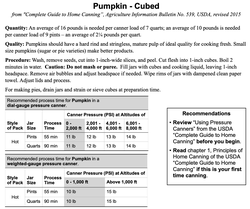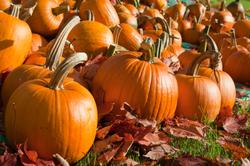Pumpkins
Nov. 20, 2024 original article not found, but information still current; fixed all other NCHFP links.
Home Preserving Pumpkins
The following was from National Center for Home Food Preservation, September 2015
Pumpkins offer far more than a door-stop at Halloween. This season is also the prime time to find and use sugar or pie pumpkins, the best for cooking and baking. Pumpkin seeds from any pumpkin can also be dried and roasted.
Think Safety
Think safety when planning to preserve pumpkins. Pumpkin is a low acid vegetable and requires special attention to preparation and processing. Use excellent sanitation in handling the fresh or preserved pumpkin. Do not let cut pumpkin sit out at room temperature for more than 2 hours during preparation prior to preserving. We have no properly researched procedures to recommend for home canning of pumpkin butters or pickled pumpkin products such as salsas, chutneys and relishes; recipes you try should be served immediately or stored under refrigeration at all times.
Canning pumpkin butter or mashed or pureed pumpkin is NOT recommended.
Home canning is not recommended for pumpkin butter or any mashed or pureed pumpkin or winter squash. In 1989, the USDA's Extension Service first published the Complete Guide to Home Canning that remains the basis of Extension recommendations today, found in the December 2009 revision. The only directions for canning pumpkin and winter squash are for cubed flesh. In fact, the directions for preparing the product include the statement, "Caution: Do not mash or puree."
Canning Cubed Pumpkin
Only pressure canning methods are recommended for canning cubed pumpkin. We have no properly researched directions to recommend for canning mashed or pureed pumpkin or winter squash, or pumpkin butter. To be safe, all low acid foods, including pumpkin, must be canned using tested pressure canning processes (Ensuring Safe Canned Foods). Older methods, such as boiling water canning for vegetables, oven canning and open-kettle canning, have been discredited and can be hazardous (Equipment and Methods Not Recommended from the USDA Complete Guide to Canning, 2015). 
Adjust lids and process following the USDA recommendations: https://nchfp.uga.edu/how/can/canning-vegetables-and-vegetable-products/winter-squash-and-pumpkins-cubed/.
Freezing Pumpkins
Freezing is the easiest way to preserve pumpkin, and it yields the best quality product. Select full-colored mature pumpkin with fine texture (not stringy or dry). Wash, cut into cooking-size sections and remove seeds. Cook until soft in boiling water, in steam, in a pressure cooker, or in an oven. Remove pulp from rind and mash. To cool, place pan containing pumpkin in cold water and stir occasionally (So Easy to Preserve, 2006). Pack into rigid containers leaving headspace, and freeze.
Drying Pumpkin and Pumpkin Seeds
Wash, peel, and remove fibers and seeds from pumpkin (or Hubbard squash) flesh. Cut into small, thin strips no more than one-inch wide by 1/8-inch thick. Blanch strips over steam for 3 minutes and dip briefly in cold water to stop the blanching action. There is no need to cool to room temperature prior to drying. Drain excess moisture. Dry the strips in an electric dehydrator until brittle.
Pumpkin also makes excellent dried vegetable leather. Purée cooked pumpkin and strain. Add honey and spices, and then dry on a home food dehydrator tray. https://nchfp.uga.edu/how/dry/recipes/vegetable-leathers/.
Drying seeds and roasting seeds are two different processes. To dry, carefully wash pumpkin seeds to remove the clinging fibrous pumpkin tissue. Pumpkin seeds can be dried in the sun, in an electric dehydrator at 115-120°F for 1 to 2 hours, or in an oven on a very low, warm temperature only, for 3 to 4 hours. Stir them frequently to avoid scorching. Dried seeds should not be stored with any moisture left in them.
For more on storing dried vegetables, see recommendations here: https://nchfp.uga.edu/how/dry/drying-general/packaging-and-storing-dried-foods/.
To roast the seeds, take dried pumpkin seeds, toss with oil and/or salt and roast in a preheated oven at 250°F for 10 to 15 minutes.
Pickling Pumpkin
Pumpkin can be used in pickled recipes such as salsas, chutneys, and relishes; however, your recipes for these must be treated as fresh prepared foods and kept refrigerated. We do not have tested recipes and procedures to recommend for safely canning these types of products by either the boiling water or pressure canning method.
Pumpkin Preserves
Gelled preserves rely on the natural acidity present in most fruits for safe food preservation. Most fruits have natural acids so resulting jams or jellies can be safely canned in a boiling water bath process. Pumpkin, however, is a low acid vegetable and cannot be safely canned in the boiling water bath process. A jam or sweetened preserve would have to have enough sugar and/or added acid to be treated safely without concerns about botulism. A certain acidity level is also required to cause the pectin molecule to form a gel structure. The USDA and Georgia Cooperative Extension currently do not have any tested recipes to recommend for safely canning pumpkin preserves (jams, jellies, conserves, or pumpkin butter) and storing them at room temperature. These pumpkin products must be stored in the refrigerator or freezer and treated the same as fresh pumpkin.
Refer to https://nchfp.uga.edu/faqs/canning-vegetables/category/faq-canning#faq-canning-vegetables-11, "Why do you say not to can mashed or pureed pumpkin or winter squash?" for more information.
This revises a similar publication originally written by Brian A. Nummer, National Center for Home Food Preservation, October 2002. This material is based upon work supported by the Cooperative State Research, Education, and Extension Service, U.S. Department of Agriculture, under Agreement No. 00-51110-9762.

